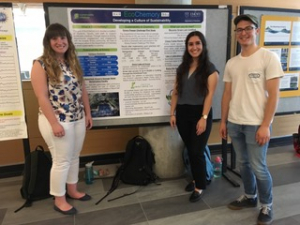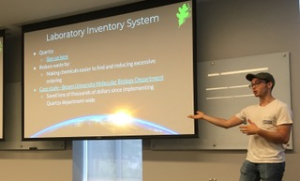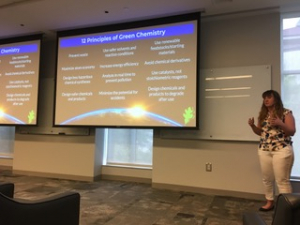EcoChemory: a Sustainability Project in the Department of Chemistry

EcoChemory was created by Dr. Kevin Sullivan (Hill Lab, Dept. of Chemistry), Elena Jordanov (Saikawa Lab, Dept. of Environmental Health), and Rachel Bender (Heemstra Lab, Dept. of Chemistry). The overall goal of EcoChemory is to incorporate the culture of sustainability into chemistry labs. We aim to create a coalition of scientists, researchers, and students of the Department of Chemistry who are in support of sustainable laboratory practices. A few key ways to do this includes, but is not limited to:
-
-
-
-
-
- Increased resource-sharing throughout the Department
- Engagement on sustainable practices within the Department
- Department engagement with the rest of Emory’s community on the different facets of sustainability
-
-
-
-
EcoChemory attends the group meetings of research laboratories in the Department of Chemistry and discusses options for sustainability in chemistry with PIs and lab members. Below are resources that EcoChemory endorses for labs, which are included in all of our presentations. For any questions or comments about EcoChemory, feel free to reach out to Elena Jordanov at vjorda3@emory.edu or Rachel Bender at rachel.bender@emory.edu.
EcoChemory Resources
Green Labs at Emory
Green Labs at Emory is a voluntary sustainability certification program for Emory research, teaching, and healthcare labs. Participating labs catalogue their sustainability achievements to date and identify actions to pursue, and earn recognition through certification and Emory communications channels. Through the Green Labs at Emory program, the Office of Sustainability Initiatives hopes to build a network of champions in Emory’s laboratories, and also facilitates special projects such as the inclusion of laboratories in Emory’s Laboratory Waste Policy, which was piloted in the Rollins School of Public Health in Summer 2019.
The Green Labs Incentives Fund
The Incentives Fund allows all certified Green Labs to apply for up to $5,000 in funding for initiatives that benefit sustainability practices in the lab. Examples of previously funded Incentives Fund Projects from the Department of Chemistry:
- Jui Lab: Uses a chiller to reduce carbon footprint
- Salaita Lab: Environmentally friendly biosafety cabinet which recirculates air
- Wuest Lab: Minimizing disposables
- Hill Lab: Replacing a water pump with a vacuum pump
- Blakey Lab: Elimination of oil baths and water aspirators
Laboratory Inventory System
An easy way labs can reduce waste is by utilizing a laboratory inventory system. This increases a lab’s efficiency by not only making it easier to find chemicals in the lab space, but also reduces excessive ordering.

An inventory system that Dr. Sullivan greatly advocates for is Quartzy, because of its potential for department-wide sharing. Once your own inventory is uploaded to Quartzy, you are able to add fellow researchers in other labs to your Quartzy, and vice versa. This allows for micro-scale resource sharing when, for example, trying out a new experiment that wouldn’t justify ordering an entire kilogram of a chemical if unsure whether the experiment would work. If you’re in the Department of Chemistry and you’re interested in signing up to the Department’s Quartzy account, sign up here.
Read about the benefits of department-wide resource sharing through this case-study from Brown University’s Department of Molecular Biology, where tens of thousands of dollars were saved by implementing Quartzy department-wide.
Hood Sashes
Fume hoods account for approximately 40% of energy consumption in laboratory buildings. The energy used to power one fume hood is equal to the energy used to power three average-sized American houses. Therefore, it is extremely important to close the hood sash when the fume hood is not immediately in-use. Sharing this practice with fellow lab members could lead to significant reductions in energy consumption and associated CO2 emissions.
Read about Harvard University’s Shut-the-Sash Program, which led to 70% energy savings, annual cost savings of $200,000-250,000, and an annual reduction of CO2 emissions by 300-350 metric tonnes.
Refrigerator and Freezer Management
Proper refrigerator and freezer management has significant benefits for general lab efficiency as well as significant reductions in overall energy consumption and associated CO2 emissions. By organizing your samples, taking inventory, and cleaning out your equipment, a lab group is able to work more quickly and more readily while performing experiments. Furthermore, by defrosting your equipment, keeping your equipment full at all times, and promoting shorter intervals of opening/closing doors, you lessen the load on the equipment so that it performs more efficiently and lasts longer.
The Emory Freezer Challenge Pilot Study in the Department of Chemistry
Over the Summer of 2018, the Department of Chemistry hosted the Emory Freezer Challenge Pilot Study where chemistry labs volunteered to compete against each other by performing different management practices. The Pilot Study was crafted from the International Freezer Challenge, where research labs and institutions around the globe compete against each other to best manage their cold-storage equipment. Five chemistry labs participated in the Emory Freezer Challenge Pilot Study:
Read more about the background of the Emory Freezer Challenge Pilot Study here to see the specific practices that the labs had to engage with.
Temperature Tuning
Did you know that the push for -80°C ultra-low temperature freezers (ULT freezers) was a marketing technique by manufacturers? Raising the temperature of the ULT freezers from -80°C to -70°C could lead to up to a 40% energy reduction. One ULT freezer can consume the same amount of energy from a single-family household every day [1]. During the Emory Freezer Challenge, the Lutz Lab was the only lab who temperature tuned their ULT freezer.
DNA, proteins, and competent cells can be stored at -70°C for years. Check out this live spreadsheet where research labs from multiple universities report specific samples stored at -70°C and the duration the sample was stored at that temperature.
Green Chemistry
Sustainable and green chemistry in very simple terms is just a different way of thinking about how chemistry and chemical engineering can be done. […] Green chemistry takes the EPA’s mandate a step further and creates a new reality for chemistry and engineering by asking chemists and engineers to design chemicals, chemical processes and commercial products in a way that, at the very least, avoids the creation of toxics and waste.
– American Chemical Society on Green Chemistry [2]

Since the green chemistry movement began in the mid-20th century, the field has greatly developed up to present-day. In 2019, there are green chemistry journals and conferences where researchers can share new, sustainable experimental designs and developments. Today, there are new technologies for catalyst discovery, biofuel development, and production of less toxic materials. However, most mainstream chemical industries have not yet fully embraced the technology, as more than 98% of organic chemicals are still derived from petroleum [3].
In your research lab, implementing any of the 12 Principles of Green Chemistry, such as using safer solvents and reactions conditions, or increasing energy efficiency, leads to greener chemical processes or products.
_____________________________________
References
[1] The International Freezer Challenge. “Temperature Tuning.” May 2018. https://www.freezerchallenge.org/temperature-tuning.html
[2] The American Chemical Society. “What is Green Chemistry?” Green Chemistry. June 2019. https://www.acs.org/content/acs/en/greenchemistry/what-is-green-chemistry.html
[3] The American Chemical Society. “Green Chemistry Examples” Green Chemistry. June 2019. https://www.acs.org/content/acs/en/greenchemistry/what-is-green-chemistry/examples.html
